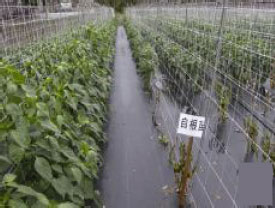Tainan, Taiwan
June 26, 2009
Source:
Deng-lin Wu, Crop
and Ecosystem Management -
AVRDC - The World Vegetable
Center - Newsletter
| |
 |
|
Open
field experiments: grafted pepper (left) vs. non-grafted
pepper |
More than 85 sweet pepper growers
and 15 nursery owners attended the field day conducted on 12
June 2009 in Nantou County, Central Taiwan to showcase the
benefits of grafting technology for sweet pepper production in
Taiwan during the hot-wet season. Sweet pepper production during
the hotwet season is limited because of high temperatures,
waterlogging (flooding), and high incidence of soil-borne
diseases, particularly bacterial wilt and Phytophthora blight.
Since 2006, AVRDC has been developing an integrated crop
management approach to address these constraints and to improve
sweet pepper production during off-season. The management
package consisted of grafted pepper plants and protective rain
shelters. Using resistant chili rootstocks and growing sweet
pepper under shelters can reduce the incidence of diseases by 90
percent and boost yield by more than 100 percent.
During a plant survey, seven promising chili rootstocks were
identified with high resistance to bacterial wilt and
Phytophthora blight. These rootstocks resulted in higher yields
of grafted sweet pepper compared to non-grafted
plants. Rain shelters are also important: Yield of grafted sweet
pepper transplants grown in the open field was 16.1 t/ha lower
due to heavy rainfall than grafted peppers grown under
protective shelters. All non-grafted plants grown in the open
field and under shelter were susceptible to bacterial wilt,
resulting in zero yield.
Pepper grafting is the next generation of improved production
technology and will impact pepper production during the hot-wet
season not only in Taiwan, but throughout the whole of tropical
Asia. |
|